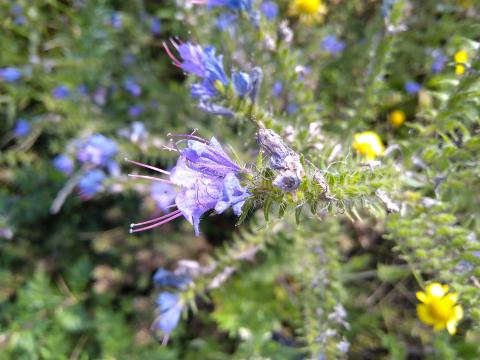Viper's Bugloss

Viper's bugloss has a pretty blue-purple flower, yet what of its intriguing name? The viper part comes from its spotted stem, possibly resembling a snake's markings, while its flower's shape resembles the snake's head. 'Bugloss' comes from the Greek meaning 'tongue of the ox' and refers to the rough, tongue-shaped leaves. Fittingly, it is indeed poisonous like a viper, especially to horses, cattle and oxen; if eaten, pyrrolizidine alkaloids accumulate of in the liver, harming the creature from within.
I am reminded of the serpent in Eden. The creature did not speak to the woman as a snake, for those furtive, hissing creatures are bereft of speech. No, I believe it spoke to her like a human. We might say it had the venom of a devil but the tongue of a man. Perhaps this is one of the reasons Eve fell so promptly; this was no terrifying, thunderous yell, like the voice of the Lord booming on Sinai; it was a gentle and winsome whisper, a pleasant and soothing drawl, such as her beloved husband might have had.
Beware of the flattering, the pleasing, the smooth. Seek rather than the plain, wholesome voice of gospel truth.
And I, brethren, when I came to you, did not come with excellence of speech or of wisdom declaring to you the testimony of God. For I determined not to know anything among you except Jesus Christ and Him crucified. I was with you in weakness, in fear, and in much trembling. And my speech and my preaching were not with persuasive words of human wisdom, but in demonstration of the Spirit and of power, that your faith should not be in the wisdom of men but in the power of God. 1 Cor. 2:1-5
- Log in to post comments


 Sunday Worship 10.45am & 6.00pm
Sunday Worship 10.45am & 6.00pm